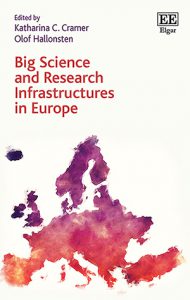What are Research Infrastructures and what roles do they play in the European integration process? These and other questions are addressed in recently published book Big Science and Research Infrastructures in Europe, edited by Katharina Cramer and Olof Hallonsten. In this Q&A with Europe of Knowledge blog, they explain origins, key concepts and findings of this book.

Q1: What have been the rationales and origins of this book? The book was first proposed within the scholarly community of the BSRI (Big Science and Research Infrastructures) Network which consists primarily of early-career scholars in the social sciences and humanities with an interest in Big Science and Research Infrastructures. The network was founded in 2017/2018 at Lund University, Sweden that plays a very active role within the European community of Big Science studies. The main rationales for this book were to add clarity and stringency to the study of Big Science and Research Infrastructures, to improve our understanding how these two categories can be understood and differentiated and to launch the study of Research Infrastructures as a new promising line for multidisciplinary research in the social sciences and humanities.
Q2: How are research infrastructures similar to and / or different from infrastructures in other areas such as transport infrastructures or communication infrastructures? We propose to differentiate between research infrastructures (non-capitalized) and Research Infrastructures (capitalized). We argue that research infrastructures can be characterized by the general meaning of infrastructures, namely, that they are resources that provide the baseline for some kind of activity. But such a perspective is too vague to add any analytical value to the study of particularly large and complex research projects. With such a view, probably anything can be a research infrastructure and there also seems to be considerable overlap with other kinds of infrastructures such as communication infrastructures or transport infrastructures.
This said, our main focus is on Research Infrastructures (capitalized) that we regard as a specific policy concept that importantly matters within the current science policy strategies of the EU and its member countries. Research Infrastructures, too, are not all of one kind, but they include single-sited and distributed projects, virtual efforts such as digital collections or cloud-based computing resources and mobile infrastructures such as research vessels. But, most importantly perhaps, we regard Research Infrastructures as a highly politicized phenomenon: They are Research Infrastructures to the extent that they were branded as such by policy makers and political representatives.
Q3: The book demonstrates the roles that Big Science and Research Infrastructures have played in the European integration process during the second half of the 20th century. What is their role today when European integration faces challenges of Brexit and rise of nationalism? With regard to Brexit, it probably is too early to assess and fully understand how this political turning point in the history of European integration might impact the establishment and operation of collaborative Big Science projects in Europe and the role of the United Kingdom within these efforts. But we know from the history of Big Science collaborations in Europe that the United Kingdom has always been a challenging but important partner. To the extent that controversy and disarray between the United Kingdom and other member countries emerged e.g. around the issues of financial contributions or site selection, in most cases, countries could find common ground to bring collaborative efforts on track. We can only speculate whether these historical patterns will also remain true for the future of European Big Science collaborations when the United Kingdom is no longer a member of the EU.
On the other hand, European Big Science projects have never been limited to EU member countries. As intergovernmental efforts they also often included partners from outside the EU (and the EEC) and even outside Europe. Funding, organization and operation of European Big Science collaborations and Research Infrastructures have been formally disentangled from common EU policy efforts and funding schemes. From this perspective, Brexit is perhaps not such a big challenge for European Big Science collaborations than it might be for European politics. But of course, there are more challenges ahead for European Big Science collaborations than Brexit. Since the early 2000s, we have also observed how Russia has become an important partner in European Big Science and now is the second biggest shareholder in some major projects such as the European X-Ray Free Electron Laser (XFEL) and the Facility for Antiproton and Ion Research (FAIR).
Q4: The book focuses on Europe. Can similar Big Science and Research Infrastructure initiatives be found in other parts of the world? Yes and no. The United States or Japan are, for example, other major players in Big Science hosting, for instance, SLAC (Stanford Linear Accelerator Center) or KEK (High Energy Accelerator Research Organization) that are major facilities for particle physics research or APS (Advanced Photon Source) and SPRING-8 (Super Photon ring-8 GeV) that are major light sources for research with synchrotron radiation. The organization of e.g. APS or SPRING-8 can well be compared to that of their counterpart in Europe, ESRF (European Synchrotron Radiation Facility): All of these facilities are service facilities that offer brilliant light as an experimental resource to groups of researchers that come to the facilities on a short-term basis. But we try to avoid to call such large research facilities in the United States, Japan or elsewhere also Research Infrastructures, because the kind of Research Infrastructures we refer to are, as argued above, highly politicized phenomena in Europe, and we therefore propose to use this term to stress the unique and specific European context and current policy making of the European Union. It is, moreover, unusual in non-European contexts to use the term Research Infrastructures in policymaking and planning – it appears to be primarily a European concept.
Q5: What is the impact of Covid-19 on Big Science and Research Infrastructures in Europe? The establishment of Big Science projects and Research Infrastructures has always been accompanied by political expectations. This seems to matter particularly for contemporary European Research Infrastructures which we consider, as argued above, as a highly politicized phenomenon within current EU science policy strategies. European Research Infrastructures were often characterized as facilities that inscribe into application-oriented research and as important projects contributing to solving urgent societal questions. Improving the understanding of the coronavirus and developing drugs or vaccines certainly are such questions.
Political expectations on the performance of European Research Infrastructures in the current pandemic situation are high. But we should not forget that Research Infrastructures per se cannot provide answers to these questions. But most of the Research Infrastructures that we analyze in our book are service facilities that offer experimental opportunities to the scholarly community and teams of researchers come to the facility on a short-term basis to perform their experiments. The current pandemic situation critically impacts these usual working practices at these facilities through travel restrictions and requirements of physical distancing. We thus need to bear in mind that the processes of how science is done at these facilities are not only complex and time-consuming, but also extremely uncertain under the current pandemic condition.
Q6: What are the main lessons from your book for practitioners and policy-makers? As far was we know, this is the first book that thoroughly deals with the concept of Research Infrastructures. The contributions cover a very wide array of different perspectives such as the evolving policy of Research Infrastructures by the EU, the emergence of ESFRI (European Strategy Forum on Research Infrastructures) or ERIC (European Research Infrastructure Consortium). These contributions are the state of the art of the organization, history and politics of Research Infrastructures in Europe and they hopefully provide an important source of information for practitioners and policy-makers.
Q7: What would be interesting avenues for future research? One important question certainly is to explore emerging new partners and members in European collaborative efforts beyond the Western European setting, such as Russia. A continued analysis of the seemingly ever-growing importance of Research Infrastructures in European (and EU) policymaking would also be useful, not least since the definitional work remains underdeveloped in policy circles. From a scholarly point of view at least, it remains unclear what “Research Infrastructure” really means and how the category can be demarcated. This, obviously, is a task for future research efforts to take on.
Katharina C. Cramer is a historian specialized in the history and politics of science and technology and the power of knowledge in the 20th and 21st centuries. She is author of A Political History of Big Science: The Other Europe (Palgrave, 2020).
Olof Hallonsten is a sociologist of science specialized in the science-society interface and the internal organization of science. He has done several studies of the politics and organization of contemporary Big Science, and is the author of Big Science Transformed: Science, Politics and Organization in Europe and the United States (Palgrave, 2016). He is currently at Lund University, Sweden.
This post was initially published on Europe of Knowledge blog.

